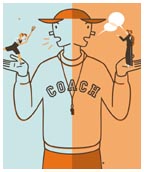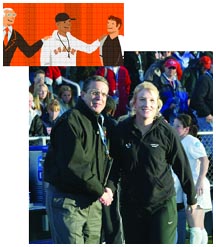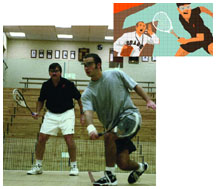January 26, 2005: Features
Update
March 28, 2005:
RESULTS
OF PAW’S ONLINE SURVEY ON ETHICAL DILEMMAS
PAW
received 36 responses to its online survey of 14 hypothetical situations
that were used in research on “cognitive conflict and control in
moral judgment” by Princeton researchers Joshua D. Greene *02, Leigh
E. Nystrom, Andrew D. Engell, John M. Darley, and Jonathan D. Cohen. You
may recognize some of these examples as dilemmas posed by contemporary
moral philosophers at Princeton and elsewhere. The survey accompanied
the online contents of our special Jan. 26 issue on “Exploring Ethics.
”
Click here to read the ethical scenarios and compare your responses to other PAW readers.
 Good
Sports
Good
Sports
Coaches drill character along with game strategy
By Brett Tomlinson
Illustrations: Leo Espinosa; Photographs: Beverly Schaefer
Charles Goodwin ’93 played squash for four years at Princeton, honing his skills during hundreds of hours on the court and eventually serving as a team captain for the national champion Tigers in his senior season. But one of his most vivid memories comes from 1990, when he was a freshman. In Princeton’s annual meeting with arch-rival Penn, the Tigers and Quakers evenly split the first eight matches. The outcome hinged on the ninth and final match, in which Goodwin was struggling to find an edge against an older and more experienced competitor.
With all eyes on Goodwin’s court, the game became more than just a test of rackets. The players expended every ounce of energy. Elation and frustration seesawed with each successive point. Calls were disputed and tension surfaced in a sport that relies on players to be their own referees. At one point, his competitor hit Goodwin with the ball — which Goodwin believes was “absolutely intentional.”
Goodwin, however, maintained his focus, defeating his opponent and keeping his composure. “When you have someone challenging you, how do you respond?” Goodwin says of the match. “Do you want people to put an asterisk next to your win because you cheated?” The victory was one of his most rewarding Princeton experiences, says Goodwin, a former venture-capital executive who now works at IBM. For that, he credits his coach, Bob Callahan ’77, who from the first day of practice stressed integrity and fair play.
Despite the high stakes of that match, Callahan did not use more seasoned players and decided to give Goodwin a chance to contribute. Challenges, after all, are part of life, even for 18-year-olds. “At some point, they’re going to be 40 years old and making some difficult decisions,” Callahan says, “and hopefully, they’ve had some practice in making the right decisions when things were a little stressful.”
Student-athletes deal with obstacles and questions like the ones Goodwin faced on an almost-daily basis, both on and off the field of play, but finding the right answers is not a solitary pursuit. Coaches serve as motivators, supporters, critics, and guides along the way, forging bonds that often carry on beyond the four years student-athletes spend on campus.
While the relationships coaches and players share have the potential to instill lasting values, that outcome is by no means guaranteed. According to Athletics Director Gary Walters ’67, education through athletics requires a conscious effort to instill commitment, integrity, ethics, and sportsmanship, an approach he calls “character-based coaching.”
Part of Princeton’s character-based approach involves finding the right people. In hiring coaches, Walters says he looks for “talent, informed by good character,” and coaches say they recruit students who show commitment, respect, and integrity. -Gary Walters ’67, athletics director Gary Walters ’67 congratulates women’s soccer coach Julie Shackford on a winning season after the Tigers’ loss to UCLA at the Final Four in December.
“As often as people say that competition develops character, I don’t actually believe that,” Callahan says. “I believe competition reveals character. In competition, your inner self will come out — sometimes good, sometimes bad.” -Bob Callahan ’77, squash coach Bob Callahan ’77, left, scrimmages with junior Yasser El Halaby, the nation’s top collegiate player, during a December practice session. |
In the mosaic of photos and plaques on his office walls, Walters prominently displays framed quotations about coaching and character by the likes of Walt Whitman (“I am the teacher of athletes ... ”) and the late Nobel Prize-winning economist and Princeton professor Sir W. Arthur Lewis (“In the university, we build character no less than brain ... ”). Walters knows good coaching. A former basketball star who played for longtime Princeton coach Pete Carril in high school and for Carril’s mentor, Butch van Breda Kolff ’45, in college, he was a successful basketball coach in his own right, serving as an assistant at Princeton and as head coach at Middlebury, Union, Dartmouth, and Providence. But Walters’ more recent experience in the business world is as much a driving force behind his push for good coaching as his background in athletics.
In Walters’ nine years at the investment firm Kidder Peabody, which included five years as a senior vice president, partner, and resident manager of the Boston office, his work included hiring recent college graduates. When he interviewed candidates, he noticed that even the best and brightest grads had a relatively small number of adult role models at college. Students interact with dozens of faculty members, but few professors or advisers become lasting mentors. A coach has a chance to be one of those rare mentors, and Walters aims to provide his coaches with every opportunity to make that happen.
Part of Princeton’s character-based approach involves finding the right people. In hiring coaches, Walters says he looks for “talent, informed by good character,” and coaches say they recruit students who show commitment, respect, and integrity. Identifying those traits during a recruiting visit, when students are clearly trying to impress, is an imperfect science, even for a veteran like Fred Samara, whose 23 years with the men’s track and field team make him one of the University’s most experienced coaches. But it’s worth the effort. “I view the personal side, the character side, as the most important aspect [of coaching],” Samara says. “If you don’t have that, you’re not going to get where you want to go.”
On campus, the relationship between coach and player begins with setting boundaries, as coaches introduce freshmen to the program by explaining everything from basic rules, like not cursing on the field or keeping the locker room clean, to more important issues, like balancing coursework and practice time. The extraordinary amount of time coaches spend with their players at practices and team meetings and on bus rides that can last eight or nine hours builds interpersonal relationships almost by default, but the bond goes beyond just spending time together. In 2003, for instance, women’s ice hockey coach Jeff Kampersal ’92 realized that spending Thanksgiving on campus meant his players would be missing their family holiday gatherings. So he created the best alternative he could, squeezing the entire team into his apartment for a full turkey dinner. “At most schools, players have a good relationship with their coaches, but I don’t know how much it extends outside the rink,” says Kim Pearce, a sophomore on the women’s hockey team and a member of Princeton’s Student-Athlete Advisory Committee. “Our coaches are there for you, no matter what, and that was made apparent so early in freshman year.”
As they learn about their teams, coaches can see when the rigors of Princeton’s academics are putting stress on the players. “We are truly along for this academic journey with these guys,” says men’s lacrosse coach Bill Tierney. “You know when they’re taking midterms; you see the bleary eyes at thesis time.” Coaches listen, on matters both academic and personal, and they advise. But the nurturing has limits, says women’s lacrosse coach Chris Sailer. “You hope that you’re someone that [students] are going to trust and feel comfortable coming to if they have issues that they’re dealing with,” she says. “But I’m not their friend, I’m their coach. There definitely is a difference.”
The boundaries, however, do not diminish the value of the coach-player relationship. Kim Simons ’94, who played lacrosse for Sailer and also starred in field hockey at Princeton, learned how vital those relationships were when she graduated and began coaching lacrosse at Georgetown University. The job, she says, appealed to her competitive side, and Simons’ teams were extremely successful, making seven straight NCAA tournament appearances and reaching the national championship game twice. But the daily challenge of connecting with each of her 25 players proved just as rewarding. In May 2004, when she walked away from coaching and became an associate director of athletics at Georgetown, the relationships were what she missed most. “There are times when you like your coach, times when you hate your coach, times when you respect them, times when you disagree with them,” Simons says. “But certainly coaches are, and should be, role models.”
According to exit surveys conducted by Walters’ office, a large majority of Princeton student-athletes view their coaches as good role models — an average of 79 percent over the last four years. The athletics department surveys all graduating seniors who participated in varsity sports, whether for four years or for four days. On a 5-point scale, with 5 being excellent and 1 being poor, students give coaches a 4.21 rating on sportsmanship and a 4.25 rating on ethical behavior. Outside Princeton, the need for character-based coaching is drawing attention, according to Myles Brand, president of the NCAA. In an interview during his recent visit to campus, Brand said that coaching associations, such as the National Association of Basketball Coaches, recognize the need for a group effort to provide education through athletics. “The athletics directors play a role, coaches play a key role — they have to be mentors – and the student-athletes have to understand and have to learn,” Brand says. “There’s no reason why they should come into college and know all this already.”
But does having a mentor on the sideline mean that student-athletes will pass when they are tested in matters of sportsmanship and ethics on the field? Coaches and players say it helps, in most cases. Examples of bad sportsmanship tend to stick out in coaches’ memories, in part because they are uncommon. Peter Farrell, the longtime coach of women’s track and cross country, vividly recalls a track meet from his early years when a Princeton distance runner intentionally elbowed one of her competitors. The incident escaped the official’s eye and did not affect the race’s outcome, but when Farrell confronted the runner at the finish line, she immediately knew the gravity of what she’d done. She apologized to Farrell before he could open his mouth to scold her. “Winning at all costs,” Farrell says, “is not part of the program [at Princeton].”
Callahan, the men’s squash coach for 23 years, has seen players take occasional unsportsmanlike shortcuts, even when playing against their own teammates in challenge matches. Dealing with such episodes and confronting the players involved is an important part of coaching. “As often as people say that competition develops character, I don’t actually believe that,” Callahan says. “I believe competition reveals character. In competition, your inner self will come out — sometimes good, sometimes bad.” The challenge, he says, is to recognize the negative impulses and control them.
Instances of exemplary sportsmanship, while often less visible, are just as important for coaches who hope to teach character lessons on the field. When the Princeton women’s lacrosse team defeated Maryland in a hard-fought overtime game late last season, Sailer was amazed at how gracious and sincere the Maryland players were after the game. Instead of shuffling through the handshake line and mumbling “good game” after an exhausting 66 minutes of lacrosse, they took the time to speak individually to the Princeton players and wish them well in the upcoming NCAA tournament. Sailer told her team to think about how good it felt to see a team handle a loss with such class.
Three weeks later, in the national championship game at Princeton Stadium, the undefeated Tigers lost to Virginia, missing their chance for a third consecutive national title. But despite the disappointing loss, the Princeton players remembered what happened on the field after the Maryland game, and they showed the same type of respect and sincerity in greeting their opponents. It was the gesture, not the championship setting, that made Sailer proud.
“Your character is your character, whether there are 10 people
in the stands or 10,000 people in the stands,” she says. “You
want to do the right thing.” ![]()
Brett Tomlinson is an associate editor at PAW.

Web
Exclusive: ETHICAL
DILEMMAS: A PAW Online survey
What would you do? Take
our online survey


